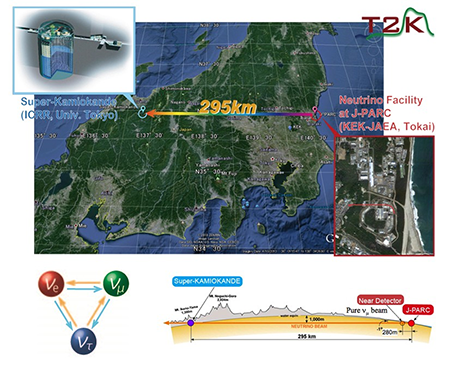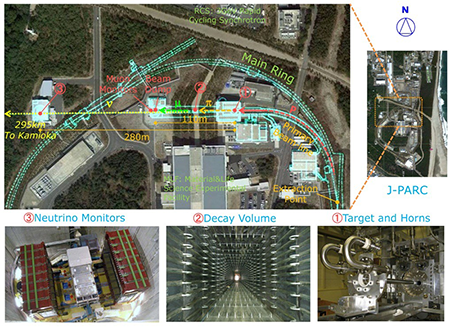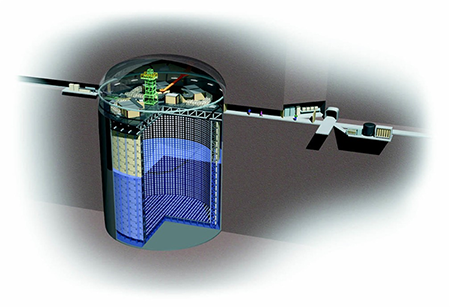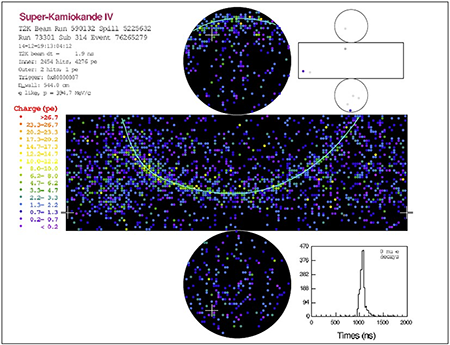| PRESS RELEASEAugust 8, 2016T2K Collaboration High Energy Accelerator Research Organization (KEK) Institute for Cosmic Ray Research (ICRR), University of TokyoJapan Proton Accelerator Research Complex (J-PARC) Center |
|
| T2K presents first CP violation search result |
The international T2K Collaboration announced today their findings on the symmetry between neutrino and antineutrino oscillation. With nearly twice the antineutrino data in 2016 compared to their initial results using antineutrino data in 2015, T2K has performed a new analysis of all data, fitting both neutrino and antineutrino modes simultaneously. Today's announcement was made by Konosuke Iwamoto, of the University of Rochester, who presented the results at the 38 th International Conference on High Energy Physics in Chicago. (LINK: http://indico.cern.ch/event/432527/contributions/2143636/) T2K's new data continue the trends observed in 2015, which is a preference for maximal disappearance of muon neutrinos, as well as a discrepancy between the electron neutrino and electron antineutrino appearance rates. |
Why the universe is dominated by matter today, instead of being comprised of equal parts matter and antimatter, is one of the most intriguing questions in all of science. One of the conditions required for the observed dominance of matter over antimatter to develop is the violation of Charge-Parity (CP) symmetry, which is the principle that the laws of physics should be the same if viewed upside-down in a mirror, with all matter exchanged with antimatter. If CP violation occurs in neutrinos, it will manifest itself as a difference in the oscillation probabilities of neutrinos and antineutrinos. |
In the T2K experiment in Japan, a muon neutrino beam is produced at the Japan Proton Accelerator Research Complex (J-PARC) located in Tokai village, Ibaraki prefecture, on the east coast of Japan. The neutrino beam is created by directing 30 GeV protons from the J-PARC Main Ring (MR) accelerator onto a cylindrical target to produce an intense secondary particle beam that is focused and filtered by strong magnetic fields called neutrino horns. The focused particle beam decays into a beam of muon neutrinos or antineutrinos, depending on the sign of the filtering done by the neutrino horns. The neutrino/antineutrino beam is monitored by a detector complex in Tokai, 280 m away from the neutrino target and aimed at the gigantic Super-Kamiokande underground detector in Kamioka, near the west coast of Japan, 295 kilometers (185 miles) away from Tokai. |
T2K's observed electron antineutrino appearance event rate is lower than would be expected based on the electron neutrino appearance event rate, assuming that CP symmetry is conserved. T2K observes 32 electron neutrinos and 4 electron antineutrinos, when they expect around 23 neutrinos and 7 antineutrinos with no CP violation. When analyzed in a full framework of three neutrino and antineutrino flavors, and combined with measurements of electron antineutrino disappearance from reactor experiments, the T2K data favor maximal CP violation. |
More specifically, the size of the expected T2K 90% confidence interval for the CP violation parameter σCP with the current data set ranges from approximately 2π (ie. the full range of σCP) to 1π, depending on the true value of σCP and the true mass ordering. The actual T2K data yield a 90% confidence interval for σCP of [-0.99π ; -0.12π] ([-0.67π ; -0.24π]) for the normal (inverted) mass ordering. The best fit points lie near the maximally CP violating value σCP=-0.5π , with the CP conserving values (σCP=0 and σCP= π) lying outside of the T2K 90% confidence level interval. |
The T2K experiment is primarily supported by the Japanese Ministry for Culture, Sports, Science, and Technology, and is jointly hosted by the High Energy Accelerator Research Organization (KEK) and the University of Tokyo's Institute for Cosmic Ray Research (ICRR). The T2K experiment was constructed and is operated by an international collaboration. The current T2K collaboration consists of over 450 scientists from 61 institutions in 11 countries [Canada, France, Germany, Italy, Japan, Poland, Russia, Spain, Switzerland, UK, and USA]. |
This observation is made possible by the tireless efforts of J-PARC to deliver high quality beam to T2K despite many difficulties, including the devastating March 2011 earthquake in eastern Japan, which caused severe damage to the accelerator complex at J- PARC and abruptly discontinued the data-taking run of the T2K experiment. |
The search for CP symmetry violation with neutrinos leverages T2K's 2013 discovery of electron neutrino appearance in a muon neutrino beam, which was the first observation of the appearance of a different neutrino flavour from the original. This appearance is an example of neutrino oscillation, a purely quantum mechanical phenomena that comes about because of the interference of neutrino flavor and mass; neutrino oscillation can only occur if neutrinos have non-zero mass. T2K's 2013 electron neutrino appearance discovery resulted in a share of the 2016 Breakthrough Prize for Fundamental Physics being awarded to Koichiro Nishikawa and the entire T2K collaboration. |
This 2016 result is based on a total data set of 1.51x10 21 protons on target (POT), which is 19% of the POT exposure that T2K is set to receive. The probability that this observation is a result of random statistical fluctuations that would mimic a neutrino-antineutrino asymmetry when none exists is about 1 in 20, motivating the need for more neutrino and antineutrino data to explore and solidify these intriguing results. The full T2K exposure of 7.8x10 21 POT is expected to come by ~2021, thanks to planned upgrades to the J-PARC MR accelerator and the neutrino beamline (LINK: http://t2k-experiment.org/2016/04/j-parc-main-ring-upgrade-approved/ ). Moreover, T2K is proposing a run extension that will lead to a full exposure of 20x10 21 POT, with 3σ sensitivity to CP violation observation (for certain values of oscillation parameters) by ~2025, when the next generation experiments are expected to begin operations. |
More details on the new T2K result, as well as prospects for future running of the experiment, can be found in the presentation file from the 38 th International Conference on High Energy Physics in Chicago, and more information about the T2K experiment can be found on the T2K public website (LINK: http://t2k-experiment.org ). |
| |
 【 Media Contacts for Further Inquiries 】 【 Media Contacts for Further Inquiries 】 
|
Globally and in Japan : Prof. Tsuyoshi Nakaya, Spokesperson, T2K Collaboration, Kyoto University (Kyoto, Japan), t.nakaya@scphys.kyoto-u.ac.jp Phone : +81-75-753-3870 |
Globally and in U.K. : Dr. Morgan Wascko, International Co-Spokesperson, T2K Collaboration, Imperial College London, m.wascko@imperial.ac.uk Phone : +44-7939-592-708 |
In Canada : Prof. Hirohisa Tanaka, University of Toronto (Toronto, Canada), htanaka@physics.utoronto.ca Phone : +1-647-549-3690 |
In France : Dr. Marco Zito, CEA/IRFU (Saclay, France), marco.zito@cea.fr Phone : +33 6 84 61 09 51 |
In Germany : Dr. Stefan Roth, RWTH Aachen University (Aachen, Germany), roth@physik.rwth-aachen.de Phone : +49 241 80 27296 |
In Italy : Dr. Maria Gabriella Catanesi, INFN Sezione di Bari (Bari, Italy), gabriella.catanesi@cern.ch Phone : +41 764871532 |
In Poland : Prof. Ewa Rondio, NCBJ, Warsaw (Warsaw, Poland), Ewa.Rondio@fuw.edu.pl Phone : +48 691 150 052 |
In Russia : Prof. Yuri Kudenko, INR (Moscow, Russia), kudenko@inr.ru Phone : +7-903-6159125 (c), +7-495-8510184 (o) |
In Spain : Prof. Federico Sanchez, IFAE, Barcelona (Barcelona, Spain), fsanchez@ifae.es Phone : +34 93 5812835 Prof. Anselmo Cervera, IFIC, Valencia (Valencia, Spain), anselmo.cervera@cern.ch |
In Switzerland : Prof. Alain Blondel, Universite de Geneve, alain.blondel@unige.ch Phone : +41 22 379 6227 |
In U.K. : Prof. Dave Wark, STFC/RAL/Daresbury Laboratory/Oxford University (Oxford, U.K.), david.wark@stfc.ac.uk Phone : +44 7788186085 |
In U.S.A. : Prof. Chang Kee Jung, State University of New York at Stony Brook (Stony Brook, NY, USA), chang.jung@stonybrook.edu Phone : +1 631-707-2018 |
About KEK : Saeko Okada, High Energy Accelerator Organization (KEK, Japan) press@kek.jp Phone : +81-29-879-6046 |
About ICRR : Hironori Fukuda, the University of Tokyo's Institute for Cosmic Ray Research (ICRR, Japan) hfukuda@icrr.u-tokyo.ac.jp Phone : +81-4-7136-5148 |
About J-PARC : PR section, J-PARC pr-section@j-parc.jp Phone : +81-29-284-4578 |
| |
 * Click here to enlarge. * Click here to enlarge. |
| Fig.1 : Overview of the T2K experiment |
| |
 * Click here to enlarge. * Click here to enlarge. |
| Fig.2 : J-PARC Neutrino Experimental Facility |
| The proton beam extracted from the J-PARC Main Ring synchrotron are directed westward through the T2K primary beam line. At the target station the protons strike a ć@target composed of graphite rods and produce numerous positively charged ā╬-mesons which are in turn focused towards the forward direction under the effect magnetic horns. The ā╬-mesons then decay into muon and muon neutrino pairs during flight in a 100-m-long tunnel, called ćAthe decay volume. ćBNeutrino detectors located 280 m downstream of the target can monitor these muon neutrinos. A comparison of the measurements with those observed at Super-Kamiokande facilitates detailed studies of neutrino oscillation. |
| |
 * Click here to enlarge. * Click here to enlarge. |
| Fig.3 : Super-Kamiokande Detector |
| The world's largest underground neutrino detector affiliated with the Kamioka Observatory of the Institute for Cosmic Ray Research, the University of Tokyo. It is situated 1,000 m underground in the Kamioka Mine in Hida, Gifu Prefecture. Super-Kamiokande is observing neutrinos from outer space and conducting experiments to detect yet-to-be-discovered proton decays, in addition to detecting neutrinos from J-PARC. This detector contains about 11,200 photomultiplier tubes, which are installed on the inside wall of a cylindrical water tank (39.3 m in diameter and 41.4 m in height) filled with 50,000 tons of water, to detect faint Cherenkov light emanating from charged particles traveling faster than the speed of light in water. |
| |
 * Click here to enlarge. * Click here to enlarge. |
| Fig.4 : An anti-electron-neutrino candidate in Super Kamiokande. |
| |
|
©2016 J-PARC Center. All rights reserved. |

